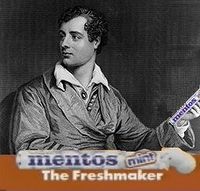User:Rcmurphy/Moose-Robot War of 1820
The Moose-Robot War of 1820 was a conflict between the massed automaton forces of Europe, the Americas, and Fiji, and Uncyclopedia writer Savethemooses (henceforward "STM"). The victor need hardly even be stated.
Tidings of War[edit | edit source]
The first conflicts between STM and the robots began around the time of the former's 1818 invention of the Pants Vaporizer. This invention threatened to put the military robots of the world in the scrapyard, since the Vaporizer was deadly, inexpensive to manufacture and could be operated by the cheapest of child laborers.
Bell Labs, which had a worldwide monopoly on robot production in the late 18th and early 19th centuries, immediately foresaw the threat that STM posed and moved quickly to optimize their existing robot lines, adding four paper clips (the Pants Vaporizer had but three) and stylish new paint jobs (in Redcoat and Washington's Wig White shades). They advertised these improved robots with the slogan "Improved Robots by Bell Labs! L@@K" to appeal to the younger demographic.
Since the younger demographic had no money, this technique did not help struggling sales.
Fog of War[edit | edit source]
Both sides knew that the key to winning the war would likely be Britain's wildly popular Poet Laureate Lord Byron. Known for such contributions to literature as the tragic Byronic hero, saucy love poetry and catchy Mentos jingles ("And if I laugh at any mortal thing, / 'Tis that I may not weep. / Mentos!"), Byron had the name recognition and influence to sway public opinion either way in the conflict.
For over a year, both Savethemooses and Bell Labs publicly pursued Lord Byron's support for their cause. While Bell Labs possessed the capital to offer Byron outrageous amounts of money to write adverts for their robots, many historians believe they fundamentally misunderstand Byron's nature in using monetary promises to seduce him.
Savethemooses, on the other hand, did understand Byron, and organized the world-renowned Kool Aid concert in Byron's honor (and to raise money for his Pants Vaporizer plants) in order to appeal to his vanity. Kool Aid was a tremendous success, raising over $10,000 and attracting such superstars as John Keats and John C. Calhoun. Future president Andrew Jackson also made a token appearance, chasing an actor dressed as a Native American across the stage to rev up the crowd before the performance of the concert's main act, the jug band Amendmentz.
Clouds of War[edit | edit source]
Byron officially announced his affiliation with Savethemooses in June 1819. The declaration appeared in all the dailies and was soon the hottest political and economic topic for the masses to discuss. On this issue there were few moderates; nearly everyone, from the most influential politicians to the scandalmongers such as James T. Callender (who revealed had faked his 1803 drowning death) to the landowning white males of the country, had an opinion.
It quickly became obvious that Byron's influence would result in the utter obliteration of Bell Labs' robot lines on the market. The question was not who would win the economic war, but whether there would be a physical war, who would win that war, and whether President James Monroe would soon declare US isolationism and deny the right of European powers to colonize the Western Hemisphere.
An inopportune slap on the part of Savethemooses resulted in a declaration of war by Bell Labs' president, Knasson Knopfler, in February 1820.
Stage of War[edit | edit source]
Popular stage productions were in fact in inadequate supply during wartime. Theatergoers could chose between the vulgar comedy Whiskey Rebellin' and the Kantian philosophical treatise Do Unto Others? A Study of the Categorical Imperative in Eight Parts, with Particular Attention Given to the Arguments of A Priori Versus A Posteriori Truth.
Men of War[edit | edit source]
The forces of Bell Labs included over 80,000 iron-and-wood robots ranging in height from three to ten feet and in arms from none to twenty. Savethemooses' forces numbered only around 30,000 and were composed of landless whites and juvenile Indonesian factory workers imported for the war effort.
Although the numbers were strongly weighted in the favor of Bell Labs, STM's troops were in general much better armed, having each a Pants Vaporizer and a pair of heavily starched pants. Additionally they had the advantage of STM's stellar leadership and brilliant battle stratagems. Many of his coined techniques, including the Austrian Pincher Movement, the Double-back Retreat and the Look, What's That Over Your Shoulder Feint, have become classic studies in military efficacy.
The war was fought largely in rural America, with secondary battles in France and Spain and at least one shouting match in Portugal.
Savethemooses, although losing nearly half of his fighting force over the course of the battle, had eliminated Bell Labs as a threat by November 1820. The Treaty of Schenectady was signed on December 3, 1820. The primary terms were as follows:
- Hostilities were ended between the two forces, effective immediately.
- Bell Labs agreed to end its monopoly on robot production to encourage economic competition.
- Bell Labs president Knopfler had to pose in his underdrawers in Boston's town square for one hour.
Dogs of War[edit | edit source]
Dogs were not utilized as weapons during the Moose-Robot War of 1820.
Spoils of War[edit | edit source]
The Moose-Robot War of 1820 effectively handed Savethemooses the keys to economic domination. With robots relegated to only a corner of the market, and with his Pants Vaporizer selling like hot Virginia tobacco-cakes, STM reaped the benefits of his invention and became by 1835 the richest private entrepreneur in the United States.
Bell Labs, devestated by its market loss, never recovered and folded in 1823.
Lord Byron, horrified by the ravages of a war for which he felt himself partly to blame, became a battlefield nurse and later received ordination in the Anglican Church. He now lives in Middle Wallop, England, with his wife Judy and three kids, George Jr., Christopher and Mandy.




